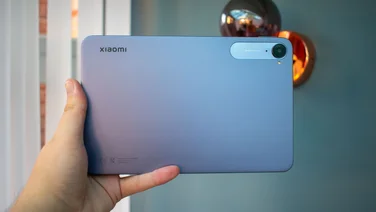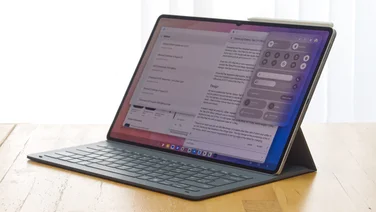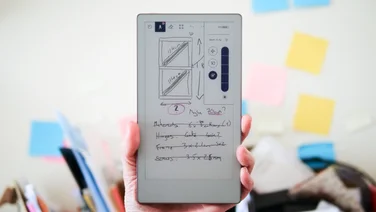To help us provide you with free impartial advice, we may earn a commission if you buy through links on our site. Learn more
- Apple iPad 10.2in (8th generation) review: What you need to know
- Apple iPad 10.2in (8th generation) review: Price and competition
- Apple iPad 10.2in (8th generation) review: Overview
- Apple iPad 10.2in (8th generation) review: iPad OS 14
- Apple iPad 10.2in (8th Generation) 2020 review: Display
- Apple iPad 10.2in (8th Generation) 2020 review: Performance
- Apple iPad 10.2in (8th Generation) 2020 review: Verdict










- Fast and responsive
- Slim and lightweight
- Reasonable price
- Webcam is mediocre
- Non-laminated display
- No USB-C
Iterative updates aren’t sexy but – I’ll admit it – they’re absolutely my favourite kind. Company A (in this case Apple) takes established and mature product B (the iPad) and improves it just a smidgen, in the process making it even better than before. It’s a win-win for all concerned.
Thus proceeds the review of the Apple iPad (8th generation). There’s absolutely nothing about it that should surprise you and nothing groundbreaking, either. But that doesn’t matter one jot because it remains the best tablet you can buy for the price and, if you buy the keyboard as well, it makes a mighty fine budget laptop replacement as well.
READ NEXT: Apple iPad Pro (2020) review
Apple iPad 10.2in (8th generation) review: What you need to know
If you hadn’t quite worked it out just yet, there isn’t really anything physically different about the eighth generation 10.2in iPad compared with its predecessor.
It still has a 10.2in IPS touchscreen with a resolution of 2,160 x 1,620 pixels and this is still compatible with the Apple Pencil, albeit with some clever new features via iPadOS 14 – more on that later.
In fact, the only significant thing that has changed in 2020 is the processor inside the iPad, which has seen an upgrade from the quad-core A10 Fusion chip of the previous two generations to the six-core A12 Bionic chip.
Apple iPad 10.2in (8th generation) review: Price and competition
Not that you should care too much about the lack of changes, because Apple has also kept the price at the same level as before.
The 10.2in iPad starts at £329 for the model with 32GB of storage and that rises to £429 if you want 128GB. You can also add cellular connectivity (4G) for an extra £130. If you plan on using the iPad as a productivity tool, the Smart Keyboard Folio case adds a further £159, giving you a very capable laptop alternative for £500.
Possibly the best thing about the body being the same size as last time, however, is that there are now plenty of good quality accessories available that can help you save money on Apple’s official peripherals. Logitech’s Slim Folio for iPad is supported (£90), as is its Crayon stylus (£65).
What can the opposition conjure up at this price? The most obvious rival has to be the Samsung Galaxy Tab S6 Lite, which comes bundled with a stylus for £339, making it a great value Android alternative.
If you’re determined to use the S6 Lite as a laptop replacement you’ll have to buy a Bluetooth keyboard as it doesn’t have the physical contact points of the iPad. It isn’t nearly as powerful, either, and Android apps don’t generally tend to work as well on tablets as iOS apps do. However, the Samsung Galaxy Tab S6 Lite does come with more base storage at 64GB.
A more serious proposition would be the recently launched Microsoft Surface Go 2, a 10.5in tablet that’s designed from the get-go to be used as a laptop. This runs Windows 10, starts at £399 for the cheapest Pentium model and you can add the Type Cover keyboard for around £94, and the Surface Pen for around £64.
Again, though, this cheaper version of the Microsoft Surface Go 2 can’t quite match the raw speed of the iPad.
Apple iPad 10.2in (8th generation) review: Overview
Normally I’d kick off the rest of a review with a deep dive on design but since the new iPad 10.2in is exactly the same as its predecessor, it almost feels a touch redundant.
Just to recap, though, the new iPad’s dimensions are exactly the same as before (174 x 7.5 x 251mm, weighing 490g) and its buttons are in all the same places. It has the same old Lightning connector (no move to USB-C here) and even the cameras are identical. There’s an 8MP f/2.4 shooter on the back and a rather disappointing 1.2MP FaceTime HD camera on the front. The eighth-Generation iPad isn’t compatible with the new Magic Keyboard, either, although that’s no bad thing given the cost.
In tandem with the Smart Keyboard Folio (which again is the same as for the previous generation iPad 10.2in), however, it’s a lovely little productivity machine and it’s now even better than before thanks to all the new mouse and keyboard features introduced along with the new iPad Pro tablets earlier in the year. In fact, combined with the new Apple Pencil features inherited from the iPadOS 14 update, this makes the iPad an even more capable laptop replacement than ever.










Apple iPad 10.2in (8th generation) review: iPad OS 14
Those Apple Pencil features aren’t the only new features in iPadOS 14 but they are the most interesting and they mostly focus on a new feature called Scribble. Essentially, this is Apple’s shot at integrating handwriting recognition into iPadOS and, in the process, giving users another reason to drop £89 on an Apple Pencil.
The idea is a simple one: just scribble some words and iPadOS will attempt to recognise your scrawl and turn it into text. This works just about as well as most handwriting recognition and, in some ways, it’s better. The system of scribbling out words to delete them is wonderfully intuitive, as is the ability to select text by either circling it or dragging over the top of it. The only thing I struggled with was scratching out single characters, which I felt was needlessly fiddly.










Scribble works best in the Notes app right now, which leaves your handwriting in place and allows you to copy and paste it, just like real text. Some of these new features aren’t limited to Notes, however, since you can also write in most text fields across iOS in most apps, from web forms to reminder lists. It’s even possible to write text into Pages and have it converted on the fly and even add data directly into cells in Numbers.










Perhaps unsurprisingly, this level of compatibility doesn’t extend to Google Docs just yet, although you can enter handwritten data into Google Sheets cells.
Slightly less useful is the system’s ability to convert barely recognised hand-drawn shapes – from circles and ellipses to stars and squares – into straight-sided geometric objects. All you have to do is draw what you want, then pause at the end and wait for the iPad to do its thing.
Apple iPad 10.2in (8th Generation) 2020 review: Display
It’s a shame, however, that Apple hasn’t updated the display on the eighth generation Apple iPad because it’s probably the tablet’s least attractive aspect these days.
That’s principally due to the fact that it hasn’t yet inherited the laminated display that Apple lavishes on the iPad Pro and Air tablets further up the range. Lamination is where the touchscreen glass is physically attached to the LCD below it and it has a couple of key benefits: it reduces glare and increases the sense of immediacy when touching the screen with your fingers or the Apple Pencil.










The standard iPad lacks the variable refresh rate of the Pro tablets, too, which can go all the way up to 120Hz and it also lacks the wide gamut Display P3 colour coverage, so it doesn’t look quite as vibrant.
Within these limitations, however, the 10.2in IPS panel used here is pretty good. It’s a Retina-class screen that has a resolution of 2,160 x 1,620 and a pixel density of 264ppi, so it’s perfectly sharp.
Colour performance is beyond reproach, too. The iPad’s sRGB coverage (90.6%) and colour accuracy (1.25 average Delta E) are both very good. It’s also quite bright, reaching a maximum of 509cd/m2 in our testing and the contrast ratio is an acceptable 1,086:1.
Apple iPad 10.2in (8th Generation) 2020 review: Performance
The big news, especially given that the price has remained the same, is that the iPad 10.2in is now much more powerful than last year’s model with the six-core A12 Bionic replacing the A10 Fusion. This comes as a welcome development, especially since the 2019 model had the same processor as the 2018 iPad.










There isn’t a hugely noticeable uplift in responsiveness, though. The iPad feels just as speedy and slick as always, with apps launching quickly and most games playing at a smooth frame rate.
However, if you do want to tax the tablet with something a little more demanding – a spot of video editing and rendering via iMovie, for instance – you’ll find the six-core A12 Bionic a more than capable companion:


As for battery life, that’s not too bad, either. Despite the hike in power, the A12 Bionic is more efficient chip than the A10 Fusion, and as a result, 2020’s iPad lasted a little longer in our video rundown battery test:

Apple iPad 10.2in (8th Generation) 2020 review: Verdict
This year’s Apple iPad 10.2in is a pretty easy recommendation. It’s the best tablet in its class in almost every area, and more powerful than anything you can buy for the money, too.
Add a keyboard – whether that be the official one or a cheaper, third-party product – and you have an exceptionally good-value laptop replacement, too.
Not much may have changed, then, but neither has my overall verdict. If you’re looking for any kind of computer – tablet, laptop or otherwise – and you have no more than £500 to spend, make it your business to put the iPad 10.2in eighth-generation (2020) right at the top of your list.



















